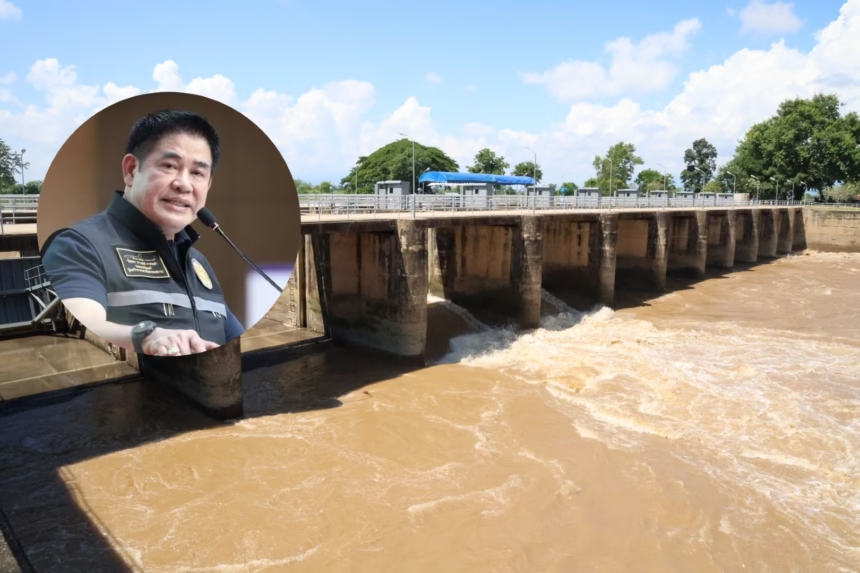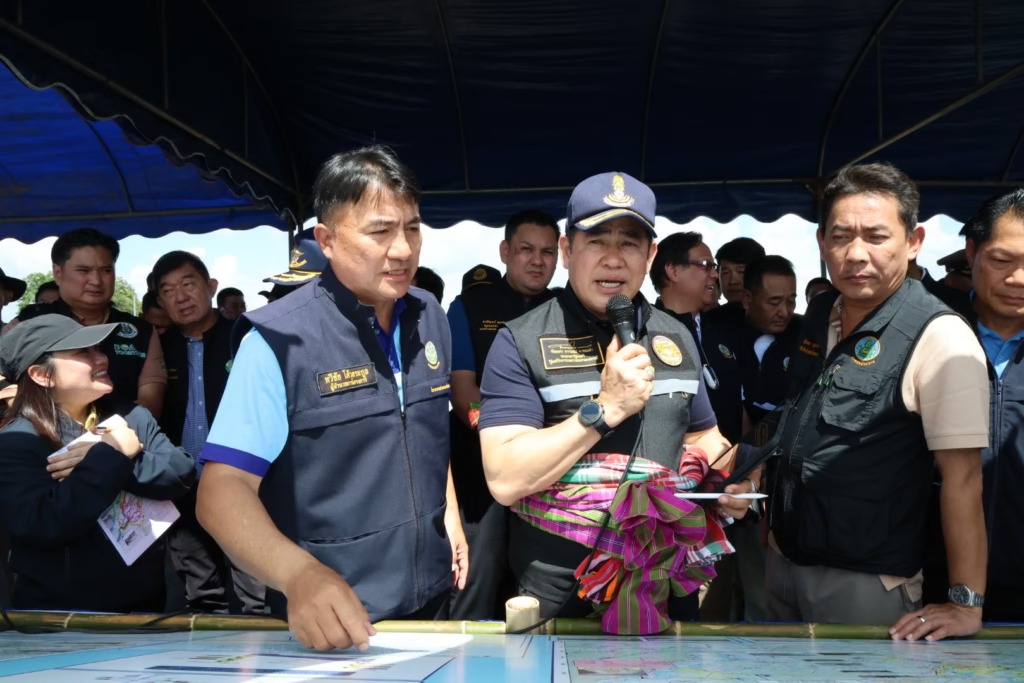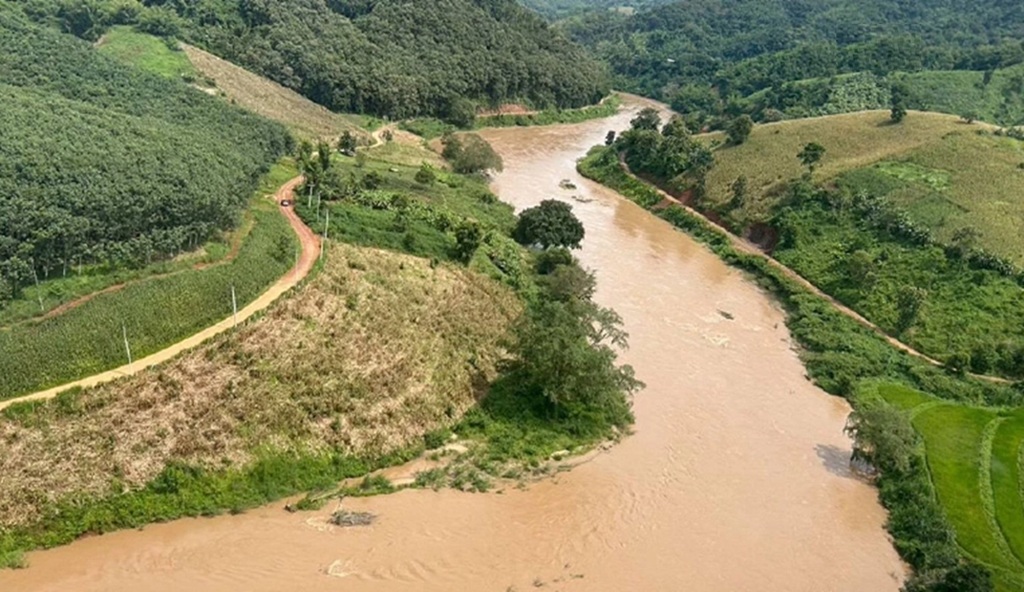CHIANG RAI – Deputy Prime Minister Thammanat Prompao visited Chiang Rai Dam in Rong Wiang, Mueang Chiang Rai, to review water management in the Kok River basin. He pushed urgent action on contamination in the Kok River, set plans to restore local water sources, and called for a fast study of a sediment trap weir at the headwaters.
Captain Thammanat was joined by Prof Dr Narumon Pinyosinwat, Minister of Education, Amin Maeyo, Deputy Minister of Agriculture and Cooperatives, Naret Thamrongtipayakun, Deputy Minister of Agriculture and Cooperatives, and senior officials from the ministry. The team inspected current conditions and water operations at Chiang Rai Dam within the Kok River basin.
Captain Thammanat said Chiang Rai Dam supports a total irrigated area of 58,723 rai across Mueang Chiang Rai, Wiang Chai, and Wiang Chiang Rung. The Royal Irrigation Department manages basin flows to reduce flooding during the rainy season and store water for dry season use.
The dam also feeds downstream irrigation schemes in the lower Kok basin. Even so, Chiang Rai still faces natural and environmental risks. These include floods and landslides, and the pressing issue of chemical residues in the Kok River that harm public health.
He stated that the first task is firm talks with neighbouring countries to set joint standards and stop chemical discharge into tributaries that flow into Thailand. The matter affects people’s lives. He will raise it in Tuesday’s Cabinet meeting so the Ministry of Foreign Affairs and security agencies can take coordinated diplomatic action.
He added that the Agriculture Ministry has acted without delay. He instructed the Royal Irrigation Department to urgently assess a headwater regulator or sediment trap weir before the river reaches Mae Ai District.
The aim is to filter and slow contaminated flows before they enter Chiang Rai. He also assigned the Land Development Department, the Royal Irrigation Department, and the Department of Fisheries to run detailed checks on water, soil, and aquatic life. The goal is to confirm these resources are safe for consumption.
He further directed the Royal Irrigation Department to secure backup water sources for Chiang Rai households, to reduce reliance on Kok River supplies, even though contamination levels are still within current standards.
He will set up a provincial committee to handle this issue. The group will include all relevant agencies and local leaders, bringing solutions to the ground. He stressed that the government and the Agriculture Ministry will act with speed, since this is a real hardship for the public, and they will not ignore it.
Sedimentation Weirs and Arsenic Control in Water
Sedimentation weirs, used in clarifiers and weir tanks, support arsenic removal by helping solids settle. They capture suspended matter, including flocs that form during pretreatment steps such as coagulation or oxidation.
They do not capture dissolved arsenic on their own. Chemical oxidation, coagulation with iron or aluminium salts, or adsorptive media are needed for that. Weirs raise overall performance by separating the precipitated solids after those steps. This improves clarity, reduces carryover, and stabilises downstream treatment.
What Are Sedimentation Weirs?
- Basic Design and Function: A sedimentation weir is a low barrier or overflow structure in a settling basin (e.g., rectangular, circular, or radial-flow tanks) that controls water flow and promotes gravity-based settling. As contaminated water enters the basin, velocity decreases, allowing heavier particles (like sediments or floc) to settle at the bottom (sludge zone). Cleaner water overflows the weir into an effluent channel, minimizing turbulence that could re-suspend solids.
- Key Parameters for Efficiency:
- Overflow Rate (Surface Loading): Typically <1,000 gallons per day per square foot (gal/day-ft²) to ensure particles settle before reaching the weir. Higher rates reduce removal efficiency.
- Weir Loading (Overflow Rate): 10,000–20,000 gal/day per foot of weir length to prevent hydraulic overload.
- Common Configurations:
- Horizontal-flow tanks (simple, used in large plants).
- Weir tanks (multi-compartment frac tanks with baffle plates for staged settling, ideal for industrial wastewater).
- These systems are cost-effective for large-scale applications, such as municipal drinking water plants or mining runoff, and can handle flows up to 500 L/second.
How Sedimentation Weirs Help with Arsenic
Arsenic in water is usually present as arsenite, As(III), or arsenate, As(V). As(III) is more mobile and harder to remove. As(V) converts to insoluble forms more readily, and is easier to treat.
Sedimentation on its own provides only partial removal. You may see around 20 to 40% reduction for As(III) when iron is present and co-precipitation occurs. When combined with oxidation to convert As(III) to As(V), followed by coagulation and flocculation, weirs help settle the flocs. In a well-designed system, overall arsenic removal can exceed 90%.















